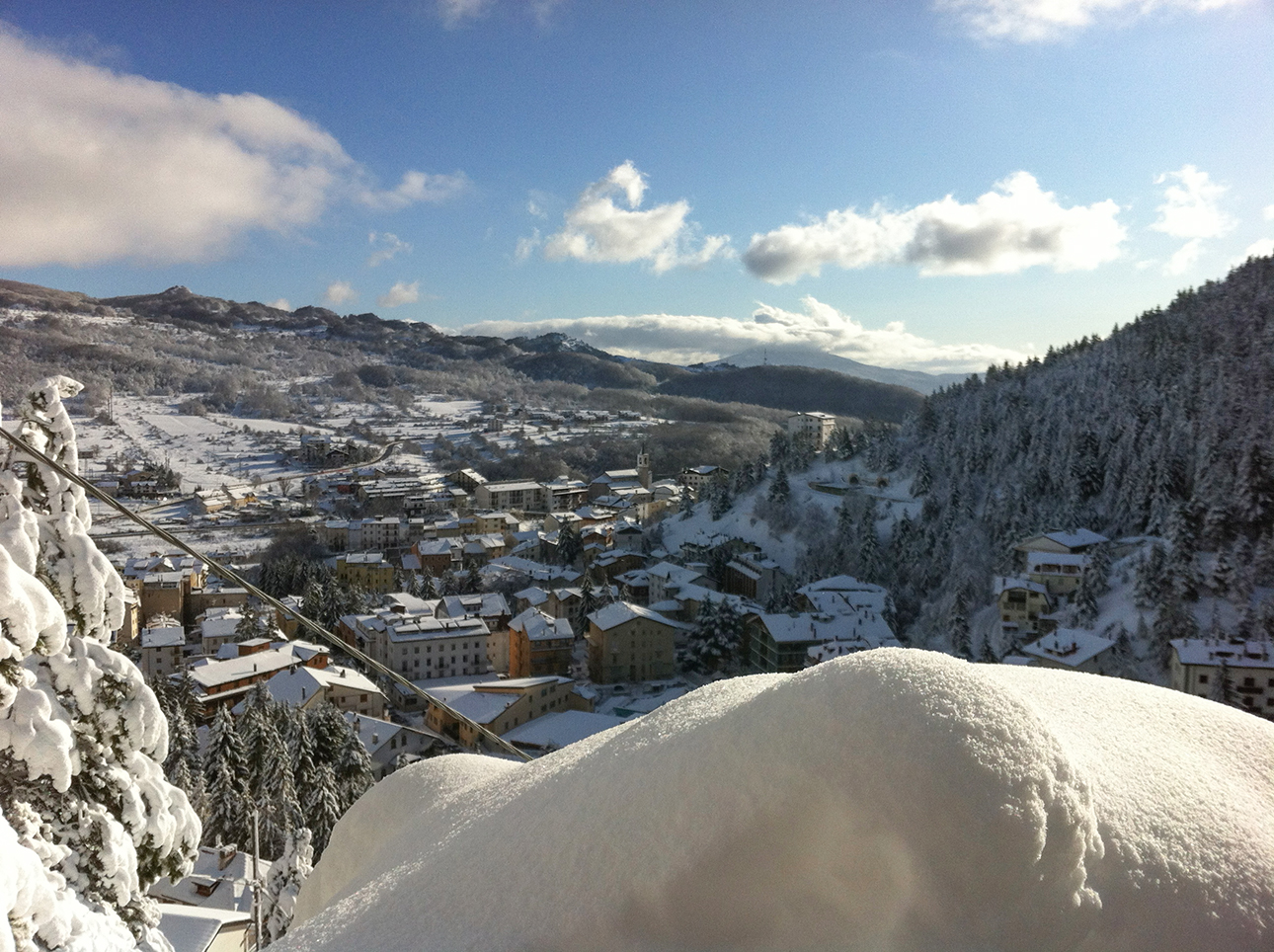
Roccaraso

By Nancy DeSanti

Credit: Wikipedia
Province of L’Aquila, Region of Abruzzo
The picturesque small town of Roccaraso is located in the province of L’Aquila. It has approximately 1,524 inhabitants, known as Roccolani. The town, in the Alto Sangro ski area, is the largest ski resort in the central Apennines, 195 kilometers from Rome. It is among the most renowned mountain resorts in central and southern Italy, and it offers tracks for cross-country and downhill skiing.
Roccaraso is the most popular ski resort in Abruzzo, considered as good as the most beautiful ski areas in northern Italy. Thanks to the efficient links to the other ski resorts, such as Rivisondoli, Pescasseroli, Pescocostanzo, Barrea, and Castel di Sangro, the resort of Roccaraso is part of a wider area, called “Comprensorio Sciistico dell’Alto Sangro e dell’Altopiano delle Cinque Miglia,” thus offering more than 150 kilometers of ski slopes and 60 kilometers of cross-country ski trails. The different resorts are linked by more than 30 modern ski lifts and are accessible by using the same ski pass.
This ski area is said to be perfect for all level of skiers, with slopes for beginners, intermediates, or advanced. These slopes are also the site of many national and international ski competitions and are equipped with snowmaking systems in case the weather does not ensure a perfect snow condition, as has happened recently. The 1,000-meter difference in altitude from the town to the peak, called Toppe del Tesoro, provides skiers with an awe-inspiring view of the charming surroundings.
In Roccaraso, there is a popular ice-skating rink and the area is equipped with two snow parks, a children’s area with a playground, and other areas for different activities–snow tubing, sledding, bobsledding, snow-racket walks, stationary biking on the snow, and Nordic walking.
Roccaraso is important historically, too. The town is on the site of a route through a nearby mountain pass, where Hannibal’s army is recorded to have travelled. The great strategic importance of the area since antiquity is shown by the presence of Caracini (an Italic population) as indicated by tombs from the 5th-4th centuries B.C.
In the Middle Ages, Roccaraso was under the control of the Benedictine monastery of San Vincenzo al Volturno. Later, Saracen raids obliged the local inhabitants to build castles where they could take refuge.
But the plague in 1656 wiped out one-fourth of the population. There is a legend that a miracle by San Rocco saved the rest of the inhabitants and, miraculously, the church they built in his honor is the only building that survived the destruction of World War II. The town was destroyed by the bombing, which caused the loss of “Interalia,” a theater built in 1698 and one of the oldest in Italy.
Earlier, a flourishing textile economy had developed over the centuries and created prosperity, but the decline of the agricultural and pastoral economy in the latter part of the 19th century started a mass emigration.
The darkest moment in the town’s history came in 1943 when the Germans established their headquarters there. A massive bombing by American forces destroyed 98 percent of the place. For revenge, the Germans destroyed nearby Pietransieri, killing 127 civilians.
After the extensive destruction by WW2 bombings, today the small center has been completely modernized, except for the district called Terra Vecchia (the ancient fortified borough) with remains of a tower, and in the lower part, the small church of San Rocco.
However, since the beginning of the 20th century, a steady recovery began with the tourism industry, thanks to a favorable position on the railway line to Naples. The first ski race was held in 1910 and the first ski lift was built in 1936.
Roccaraso was in the news recently when a wild bear known affectionately as Juan Carrito died after being struck by a car. The incident occurred on a highway leading to Castel Di Sangro, near the Roccaraso tunnel. Known as the “biscuit-loving bear,” Juan Carrito was famous for his playful nature and raids in search of food.
The animal’s increasingly daring forays into urban areas in search of food prompted park authorities to relocate him — twice — to a remote area of the mountains. However, Juan Carrito surprised everyone by making the 150-kilometer trek back to his stomping ground of Roccaraso. Tracked by a radio collar, the Marsican bear was noted for his lack of fear of humans and his playful nature towards dogs.
Aside from the region’s sentimental attachment to Juan Carrito, his loss is a further blow to the critically endangered Marsican bear, a subspecies of the brown bear. There are reportedly only about 30 of the animals left in existence, compared to 100 in 1980.
What to See
- Church of Santa Maria Assunta
- The Church of San Rocco was built in 1656 to give thanks to the saint who saved the population from a terrible plague
Important Dates
- August 13 — Feast of Sant’Ippolito of Rome, the patron saint.
Italiano

Tradotto da Ennio Di Tullio
Provincia dell’Aquila, Regione Abruzzo
Il pittoresco paesino di Roccaraso si trova in provincia dell’Aquila. Conta circa 1.524 abitanti, detti Roccolani. La località, nel comprensorio sciistico dell’Alto Sangro, è la più grande stazione sciistica dell’Appennino centrale, a 195 chilometri da Roma. E’ tra le località montane più rinomate del centro e sud Italia, e offre piste per lo sci di fondo e di discesa.
Grazie agli efficienti collegamenti con le altre località sciistiche, come Rivisondoli, Pescasseroli, Pescocostanzo, Barrea e Castel di Sangro, la località di Roccaraso fa parte di un comprensorio più ampio, denominato “Comprensorio Sciistico dell’Alto Sangro e dell’Altopiano delle Cinque Miglia”, offrendo così più di 150 chilometri di piste da sci e 60 chilometri di piste per lo sci di fondo. Le diverse località sono collegate da più di 30 moderni impianti di risalita e sono accessibili utilizzando lo stesso ski pass.
Si dice che questo comprensorio sciistico sia perfetto per tutti i livelli di sciatori, con piste per principianti, intermedi, o avanzati. Queste piste sono anche sede di numerose gare sciistiche nazionali ed internazionali e sono dotate di impianti di innevamento programmato nel caso in cui le condizioni meteorologiche non garantissero un innevamento perfetto, come è accaduto di recente. Il dislivello di 1.000 metri dal paese alla vetta, denominata Toppe del Tesoro, offre agli sciatori una vista mozzafiato sull’incantevole paesaggio circostante.
A Roccaraso è presente una rinomata pista di pattinaggio sul ghiaccio e la zona è attrezzata con due snowpark, un’area bimbi con parco giochi e altre aree per diverse attività: snow tubing, slittino e bob, passeggiate con le ciaspole, cyclette sulla neve , e nordic walking. Roccaraso è importante anche storicamente. La città si trova sul sito di un percorso attraverso un vicino passo di montagna, dove si dice che abbia viaggiato l’esercito di Annibale. La grande importanza strategica dell’area fin dall’antichità è dimostrata dalla presenza dei Caracini (popolazione italica) come testimoniano tombe del V-IV secolo a.C.
Nel Medioevo Roccaraso era sotto il controllo del monastero benedettino di San Vincenzo al Volturno. In seguito le incursioni saracene costrinsero gli abitanti del luogo a costruire castelli dove rifugiarsi.
Ma la peste del 1656 spazzò via un quarto della popolazione. Narra la leggenda che un miracolo di San Rocco salvò il resto degli abitanti e, miracolosamente, la chiesa da loro costruita in suo onore è l’unico edificio sopravvissuto alla distruzione della seconda guerra mondiale. Il paese fu distrutto dai bombardamenti che portarono alla perdita di “Interalia”, teatro costruito nel 1698 e tra i più antichi d’Italia.
In precedenza, una fiorente economia tessile si era sviluppata nel corso dei secoli e aveva creato prosperità, ma il declino dell’economia agricola e pastorale nell’ultima parte del XIX secolo diede inizio a un’emigrazione di massa.
Il momento più buio nella storia della città arrivò nel 1943 quando i tedeschi vi stabilirono il loro quartier generale. Un massiccio bombardamento da parte delle forze americane ha distrutto il 98% del luogo. Per vendetta i tedeschi distrussero la vicina Pietransieri, uccidendo 127 civili.
Dopo le ingenti distruzioni causate dai bombardamenti della seconda guerra mondiale, oggi il piccolo centro è stato completamente rimodernato, ad eccezione del quartiere denominato Terra Vecchia (l’antico borgo fortificato) con i resti di una torre, e nella parte inferior, la chiesetta di San Rocco.
A ll’inizio del ‘900 iniziò una costante ripresa dell’industria del turismo, grazie ad una posizione favorevole sulla linea ferroviaria per Napoli. La prima gara di sci si tenne nel 1910 e il primo impianto di risalita fu costruito nel 1936.
Roccaraso ha fatto notizia di recente quando un orso selvatico noto affettuosamente come Juan Carrito è morto dopo essere stato investito da un’auto. L’incidente è avvenuto sull’autostrada che porta a Castel Di Sangro, nei pressi della galleria di Roccaraso. Conosciuto come “l’orso amante dei biscotti”, Juan Carrito era famoso per la sua natura giocosa e le sue incursioni in cerca di cibo. Tuttavia, Juan Carrito ha sorpreso tutti facendo il viaggio di 150 chilometri per tornare al suo terreno calpestante di Roccaraso.
Seguito da collare radio, l’orso marsicano era noto per la sua mancanza di paura degli umani e per la sua natura giocosa nei confronti dei cani. Si dice che siano solo trenta degli animali rimasti inesistenti, rispetto ai 100 del 1980.
Le attrazioni del luogo:
- Chiesa di Santa Maria Assunta
- Chiesa di San Rocco fu costruita nel 1656 per ringraziare il santo per aver salvato la popolazione dalla grande peste
Date da ricordare:
- 13 agosto — Festa di Sant’Ippolito di Roma, patrono
May/June 2023





